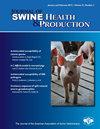Increasing creep pellet size improves creep feed disappearance of gilt and sow progeny in lactation and enhances pig production after weaning
IF 0.7
4区 农林科学
Q3 Agricultural and Biological Sciences
引用次数: 2
Abstract
Objective: To determine if feeding a larger diameter pellet increases creep feed intake and growth rate of piglets during lactation, especially that of gilt progeny (GP) compared to sow progeny (SP), and stimulates feed intake after weaning. Materials and methods: Over two replicates, GP and SP (n = 2070) were allocated to two creep feed treatments, receiving either a 4 mm diameter × 4 mm length pellet or a 9 mm diameter × 12 mm length pellet, from 3 days of age until weaning. After weaning, pigs were split into male and female pens according to the type of pellet fed in lactation and fed a common diet. Feed disappearance was recorded before and after weaning (up until 10 weeks of age), along with piglet growth performance and all piglet mortalities and removals. Results: Total creep feed disappearance in lactation was higher (P < .001) in litters offered the larger pellet, but litter weaning weight for GP was not improved (interaction, P > .05). Gilt progeny were weaned lighter (P < .001) than SP. After weaning, pigs offered the larger pellet during lactation showed a tendency to receive less medication (P = .07) than pigs offered the smaller pellet. Growth rate and feed intake after weaning were both stimulated (P = .02 and P = .09, respectively) in pigs offered the larger pellet during lactation irrespective of sex. Implications: Offering a larger pellet creep feed to piglets in lactation can improve postweaning performance and reduce the postweaning medication rate.增加蠕变颗粒粒径可改善母猪和后备母猪在哺乳期的蠕变饲料消失,提高断奶后的猪产量
目的:确定与母猪后代(SP)相比,喂养更大直径的颗粒是否会增加哺乳期仔猪的爬行采食量和生长速度,尤其是母猪后代(GP)的爬行采食量和生长速率,并刺激断奶后的采食量。材料和方法:在两个重复试验中,GP和SP(n=2070)被分配到两个爬行饲料处理中,从3日龄到断奶,接受直径4mm×4mm长的颗粒或直径9mm×12mm长的颗粒。断奶后,根据哺乳期喂养的颗粒物类型,将猪分为雄性和雌性围栏,并喂食普通饲料。记录断奶前后(直到10周龄)的饲料消失情况,以及仔猪的生长性能和所有仔猪的死亡率和死亡率。结果:提供较大颗粒物的窝仔在哺乳期的总爬行饲料消失率较高(P<0.001),但GP的窝仔断奶重量没有改善(相互作用,P>0.05)。Gilt后代的断奶重量比SP轻(P<.001)。断奶后,在哺乳期提供较大颗粒的猪比提供较小颗粒物的猪有接受较少药物的趋势(P=.07)。断奶后的生长速度和采食量都受到刺激(分别为P=0.02和P=0.09),在哺乳期提供较大颗粒的猪,无论性别如何。启示:给哺乳期的仔猪提供更大的颗粒爬行饲料可以提高断奶后的表现,降低断奶后的用药率。
本文章由计算机程序翻译,如有差异,请以英文原文为准。
求助全文
约1分钟内获得全文
求助全文
来源期刊
CiteScore
1.80
自引率
0.00%
发文量
29
审稿时长
>36 weeks
期刊介绍:
The Journal of Swine Health & Production (JSHAP) is an open-access and peer-reviewed journal published by the American Association of Swine Veterinarians (AASV) since 1993. The aim of the journal is the timely publication of peer-reviewed papers with a scope that encompasses the many domains of applied swine health and production, including the diagnosis, treatment, management, prevention and eradication of swine diseases, welfare & behavior, nutrition, public health, epidemiology, food safety, biosecurity, pharmaceuticals, antimicrobial use and resistance, reproduction, growth, systems flow, economics, and facility design. The journal provides a platform for researchers, veterinary practitioners, academics, and students to share their work with an international audience. The journal publishes information that contains an applied and practical focus and presents scientific information that is accessible to the busy veterinary practitioner as well as to the research and academic community. Hence, manuscripts with an applied focus are considered for publication, and the journal publishes original research, brief communications, case reports/series, literature reviews, commentaries, diagnostic notes, production tools, and practice tips. All manuscripts submitted to the Journal of Swine Health & Production are peer-reviewed.

 求助内容:
求助内容: 应助结果提醒方式:
应助结果提醒方式:


